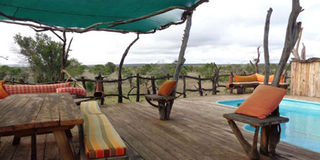Mugie Magic

Ekorian's Mugie Ranch in Mugie conservancy. PHOTO | RUPI MANGAT
What you need to know:
- Driving through the great plains of the savannah in search of the cats is a little daunting but after half an hour of following the beeps, we find Serien and her mate – a handsome golden-maned lion called Polex. As Serien stretches and Polex’s mane gets ruffled in the wind, Peter shares a tale.
- ike many of the species of Kenya’s northern drylands like the reticulated giraffe and Grevy’s zebra, the Lelwel hartebeest is also facing tough times.
- According to literature, Kenya is home to two of the seven sub-species of hartebeest: Coke’s found in southern Kenya and northern Tanzania, and Lelwel. Lelwel hartebeest once had their habitat stretching from central Kenya all the way to the Central African Republic.
A mighty elephant bull in full must* treats us to a rousing welcome with enthusiastic trumpeting as we arrive at Mugie Sanctuary in Laikipia. The stretch of Karisia Hills against the blue morning sky provides a beautiful backdrop for the flat land ahead. We drive through the grassy plains in a safari jeep, for a game drive that doubles up as a tracking exercise for the big cats.
The guides, Peter Ekuam and Ipak Longurikit, tell me that Mugie means earth in the Maa language. Ipak holds up an aerial that beeps; on the radar is Serien the lioness. We follow the beeps transmitted from the microchip in the collar she wears.
Driving through the great plains of the savannah in search of the cats is a little daunting but after half an hour of following the beeps, we find Serien and her mate – a handsome golden-maned lion called Polex. As Serien stretches and Polex’s mane gets ruffled in the wind, Peter shares a tale.
“Serien is six years old while Polex is nine. She and Lisa (her sister) are always together except during the mating season, when they go their separate ways to find mates,” he narrates.
Next on the radar are Nzuri and his brother; the cheetahs. At first the beeps are faint, coming on and off because of the trees, but they reappear once we’re on clear ground. The two spotted cats relax on a mound and we keep a distance of 30 metres from them – the distance recommended by cheetah researchers to avoid stressing the cats. They stretch and scan the plains, oblivious to our presence.
“We have two lions and two cheetahs with collars fitted by researchers,” says Ipak.
Nzuri stretches leisurely and changes position, while his brother snoozes close by. Half an hour later, we leave them so that we can explore the rest of the sanctuary. I’m hoping that today will be the day I see the African wild dog because the guys tell me they have been around.
We stop by a herd of Lelwel hartebeest, the flagship of Laikipia. Like many of the species of Kenya’s northern drylands like the reticulated giraffe and Grevy’s zebra, the Lelwel hartebeest is also facing tough times. According to literature, Kenya is home to two of the seven sub-species of hartebeest: Coke’s found in southern Kenya and northern Tanzania, and Lelwel. Lelwel hartebeest once had their habitat stretching from central Kenya all the way to the Central African Republic.
At present, this large antelope is only found in Ruma National Park in Homa Bay, and only about 12 remain there. Lakipia is their stronghold with about 1,000 animals.
The rest have suffered a doomed fate with human population growth and habitat loss. It’s estimated that by 2017, this population may reduce to 200 with possible extinction in the near future. The survival of this species depends on urgent research and management.
I am so engrossed in watching the herds like the eland and Grevy’s zebra that I fail to notice we’ve stopped at the little camp in the plains: Ekorian’s Mugie Camp that takes its name from the olive tree found on the land. Ekorian is the Turkana word for the tree.
It’s a pretty little camp with spacious luxury tents including family tents with separate space for the kids. After a little stroll around and a cup of tea, Ipak and Peter invite me for a sail on the dam. On the drive there, a large elephant bull has just stepped out of the lake; his frame half wet and half dry.
Fitted with a life jacket, the men and I kayak to the island. “It’s amazing to kayak watching elephants around the lake,” says Peter.
For fitness buffs, there’s a challenge organised by Ekorian’s Mugie Camp which involves a swim in the dam, a run and kayaking.
***
*Must is a frenzied state of male ruminants like elephants during the mating season.
THINGS TO DO
Located on the Maralal- Rumuruti Road, Mugie Sanctuary is a four-hour drive from Nairobi, but you need a four-wheel drive to get there. Apart from game drives, one can also enjoy swimming and kayaking in the dam as well as golf at the lush course. You can stay at Ekorian’s Mugie Camp or at Mutamaiyu House.




